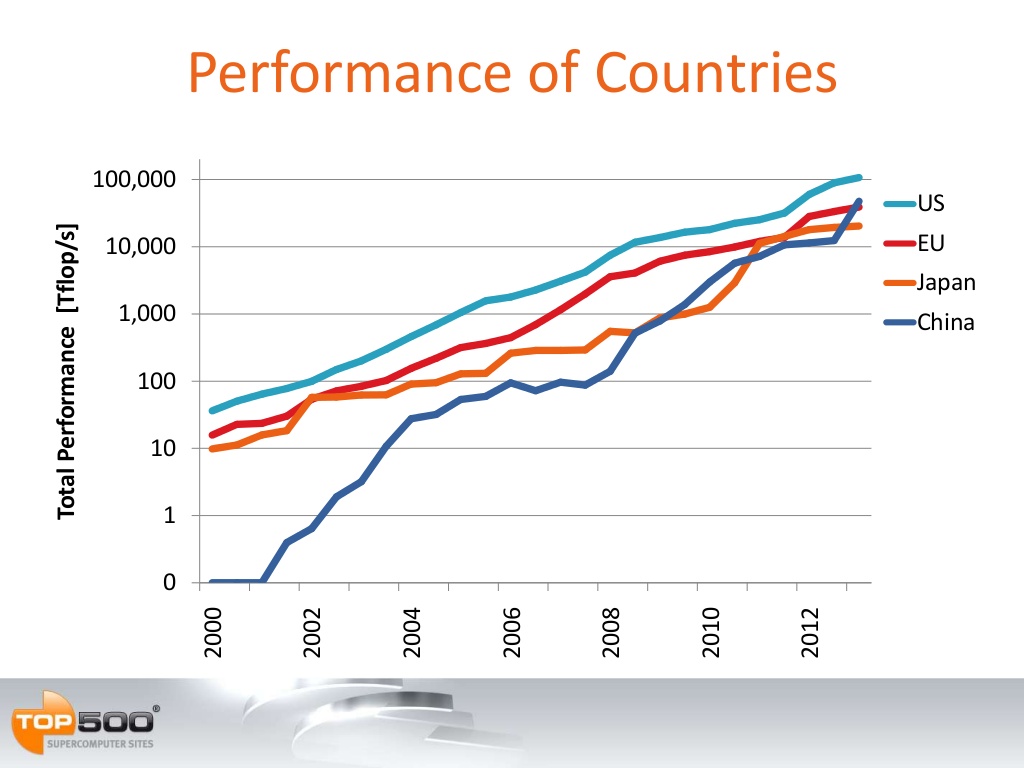China is making significant strides towards its goals to use supercomputing as the next big platform to spur economic growth. The country now makes up 13% of the Top 500 (with 51% from the United States) and with investments in homegrown technologies, it could take a much larger slice of the Linpack and list share pie by next ISC.
 While Inspur’s Tianhe-1 system moved down to the #10 spot, China still has a total of 66 systems in the rankings, almost half of which are in the top 300. According to the company’s Chief Scientist of HPC Applications, Ji Qing, we can expect to see more large-scale machines from China–not to mention some significant Linpack improvements for November’s list.
While Inspur’s Tianhe-1 system moved down to the #10 spot, China still has a total of 66 systems in the rankings, almost half of which are in the top 300. According to the company’s Chief Scientist of HPC Applications, Ji Qing, we can expect to see more large-scale machines from China–not to mention some significant Linpack improvements for November’s list.
By this point, Chinese teams have developed everything but the processor technology–although many guess that implementing some they’ve already developed (Godson/Loongson) this will be a next step. The Tianhe-2 sports the homegrown TH-Express 2 interconnect network, the Galaxy FT-1500 16-core processor, taps their own OpenMC programming model–not to mention the pulls the OS and various other elements of the stack directly from its own research and development.

The original plan for the new Milky Way or Tianhe-2 system was focused on building a 100 petaflop super by 2015. Qing says that plan hasn’t changed, and this Linpack run wasn’t the result of efforts to jump the gun. She said that there are phases for all major machines and what we saw this week at ISC was the result of the first steps. The real effort, she says, is focusing on applications so they can begin to squeeze use cases from Tianhe-2 that take advantage of the Xeon Phi boost.
Qinq ran us through the host of applications set to run on the Tianhe-2 on the research side. While many of these were the usual suspects (climate modeling, medical research, CFD) she said some of the more important applications revolve around far more specific programs. For instance, she claims that Tianhe-2 will be used to solve particular optimization problems in quantum mechanics as well as for larger computational chemistry projects.
On the industry side, however, it’s clear that China is seeing even bigger opportunities. Qing pointed to one example that could lead to , right now China is reliant on foreign aerospace companies like Boeing for many of its commercial airlines. As China seeks to boost its independence, she says that Tianhe-2 will play a major role in helping them model, design and test their own aircraft-an effort that one might guess will be extended to larger space exploration projects.
Another critical area China will explore using Tianhe-2 is seismic modeling and other research to benefit the oil and gas industry. While the nation might not be first to mind when one thinks of the segment, the Chinese oil and gas giant, BGP, will be early on the Tianhe-2 applications scoreboard as it boosts its discovery capabilities using the new super.
At the heart of this national emphasis on supercomputing is China’s longstanding 863 High Tech Development program, which will push Tianhe-2 development into successive phases while continuing to fund efforts on Loongson and the other interconnect, software and application areas in HPC. This funding is meant to encourage native technology development, but the true goal is to create a national backbone that’s strong enough to support itself–freeing China from reliance on outside parties for its prowess.
The 863 program is already the source of China’s booming telecommunications industry and has also funded some notable scientific and research projects outside of HPC, including spacecraft. If the goal is to unwind the Chinese from foreign grasp, bringing a top supercomputing resource to bear makes good sense. Qing says that they are still working with the system, adapting to Xeon Phi (a challenge since they’re using pre-production Phi parts) and porting applications (which she notes has so far been faster than GPUs, albeit not quite as heavy on the performance as a graphics coprocessor), but they will soon begin putting their new pride and joy to work for the national economic good.
“This is not only a success for China, but it’s technical progress for the entire community,” explained Qing. She noted that one positive effect of China’s dominance this year is that it might bring more HPC funding to other countries who want to compete. But in the end, she says that after all, this is about community–”people shouldn’t take this so seriously–it’s about progress for everyone.”
Qing says that between Inspur, the Chinese government and a large number of research centers, supercomputing is gaining traction and attracting new talent in China. While she described the process of finding work in HPC as highly competitive, the field is growing in part because of the attention around the Top 500.



























































